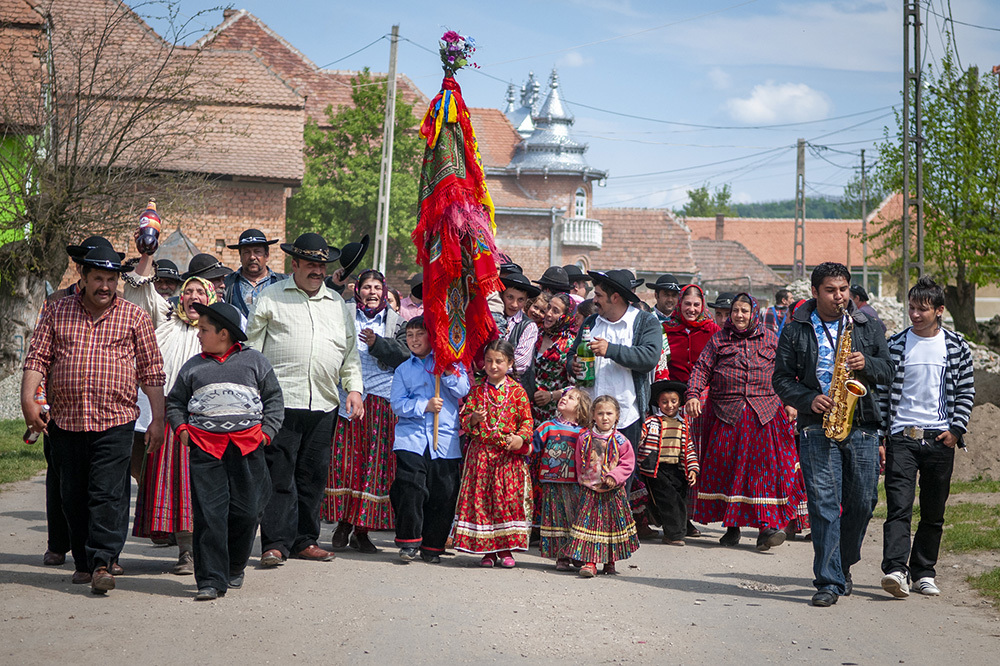
Photo credits: Eric Roset
For the Romani-speaking Cortorari (literally “Tent Dwellers”) of southern Transylvania—so called by their Romanian neighbours as a reminder of their once-itinerant way of life—marriage-making is central both to the definition of the person, and to enabling of a notion of themselves as a collective. In their own language, the Cortorari call themselves
ame al Roma, which broadly translates as “a community of married people”. The term itself derives from the singular
rom (and
romni)—a married man (and woman, respectively)—signaling that personhood begins with marriage and conception.
Often dismissed in both public discourse as a backward, traditional practice, marriage-making among the Cortorari is, in fact, deeply entangled with post-socialist transformations. Its current form is both a product and a reflection of these broader socio-economic changes. The influx of the capital coming from migration has dramatically raised cash dowries—sometimes reaching as high as €50,000—turning marriage into a major site of financial investment and status display. At the same time, sex-selective abortion has contributed to a gender imbalance at birth, intensifying competition among boys for girls on the marriage market. In keeping with their understanding of gender as grounded in the body’s reproductive capacities, Cortorari have also turned to biomedical interventions aimed at accelerating physical maturation of bodies. Added to this are global trends such as the lowering age of puberty—linked to climate change, altered diets—which have reshaped the biological and social timelines of puberty. Together, these factors have had the joint effect of lowering the marital age of spouses, reinforcing the early age at which marital alliances are arranged and formalized. What appears, from the outside, as a remnant of “tradition” is, in fact, the outcome of profound historical and global processes, refracted through local logics of kinship and economy.
Among the Cortorari, marriage is neither a single event nor a simple yes-or-no proposition between two individuals. It is an alliance between two extended families that involves economic exchanges and mobilize the political abilities of those involved, entails the reconfiguration of social relationships, and, crucially, is premised on biological reproduction and the replacement of generations within the house. Furthermore, it is a process that often begins long before the wedding itself and the cohabitation of spouses—sometimes as early as when the future bride and groom are still in their mothers’ wombs—and unfolds over many years. It is marked by the bride’s relocation from her parental home to that of her husband (which he shares with his parents), her gradual adaptation to the new household’s customs, and her gradual inclusion within it once she begins to conceive, to be completed when she had a son who can fully secure the union. Most alliances are concluded and broken off several times before a young couple, usually at puberty, come together and consummate the customary union. By that time the young have a say in the spousal choice, and in some cases might also commence a romance with their future partner. Gradually the youth embraced imaginaries of romantic love as they are circulated through social media and
manele music, which did not result in the erosion of parent authority, but an entwinement of courtship and arrangement and a very sensitive negotiation of the two.
The Cortorari do not have a specific word for “marriage.” What they do, instead, is take and give daughters—or daughters-in-law (
bori-s)—thereby binding themselves (
panden pes) into a relationship of co-in-lawship (
xanamika). When speaking about marital alliances, the ceremonies that make them public, and the agreements that underpin them, the Cortorari use the term
tokmeala. Its primary meaning refers to a marketplace situation—a moment of haggling, of negotiation over value—which aptly captures how alliances are discussed and settled. Indeed,
tokmeala brings together both economic and social dimensions: the bargaining, the exchange, the setting of terms. The ceremonial exchange involves not only the circulation of daughters but also of money and goods, most notably the cash dowry (
zestre) which is transferred from the bride’s family to the groom’s. Although this money does not go to the bride to use as she wishes, it is intended to ease her treatment and facilitate her incorporation into her husband’s household. It also serves as an index of her parents’ care for her and a testament to their industriousness. Its amount is carefully negotiated in relation to the groom’s family status and possessions—among which the chalice is particularly cherished. Ancient heirlooms that circulate from father to son, symbols of the patrilines and their prestige, the chalice counteract the tendency of marital unions towards dissolution: on the occasion of marital agreements, it is entrusted with family of the bride until the new couple has a son who will secure the union.
In contradistinction to the Romanian term
logodnă (betrothal)—widely invoked these days in public debates around the new bill, and whose primary meaning refers to the religious betrothal of two future spouses—
tokmeala is a fait social total: a ceremonial exchange that brings together economic transactions, political negotiation, and the reconfiguration of kinship and social bonds. This holistic dimension of marriage is side-lined both by the bill that focuses on the intimate relationships, and by the proponents of tradition who make recourse to the cultural identity argument. In the latter’s understanding
logodnă is reduced to a merely symbolic or cultural convention. However among the Cortorari, who combine coppersmithing with begging abroad and small-scale agriculture, securing in-laws and affines through marriage is essential to sustaining livelihoods.
To ground these broader reflections, let me turn to an ethnographic story – a marital saga that captures the entwinement of economy, politics, and kinship, as well as romance and arrangements and not least relieve women agency in the marital arrangements.


.jpg)